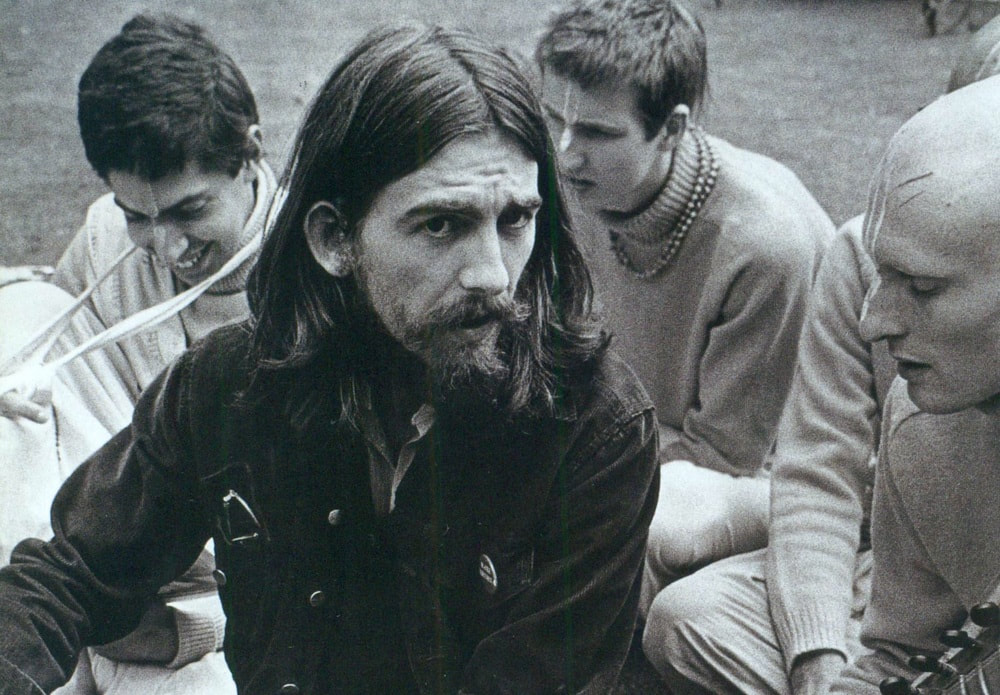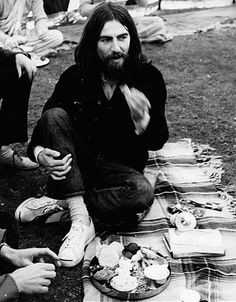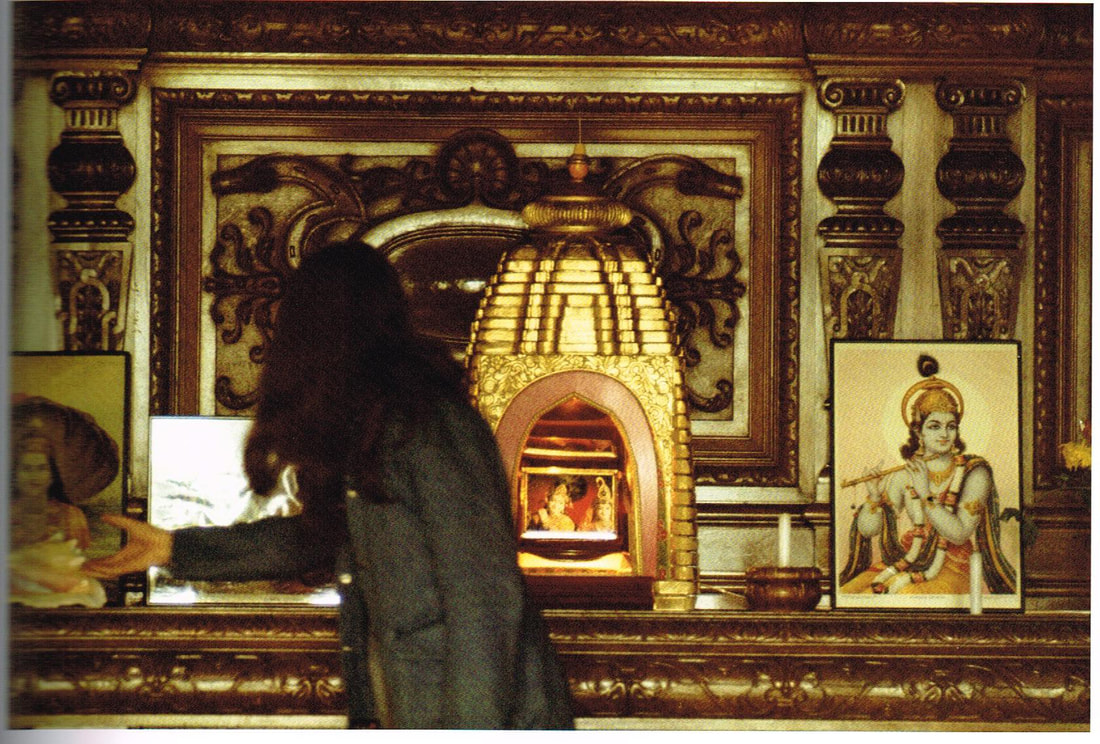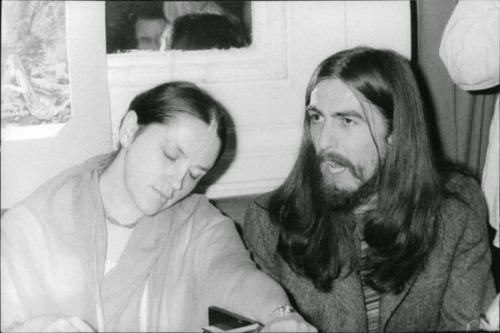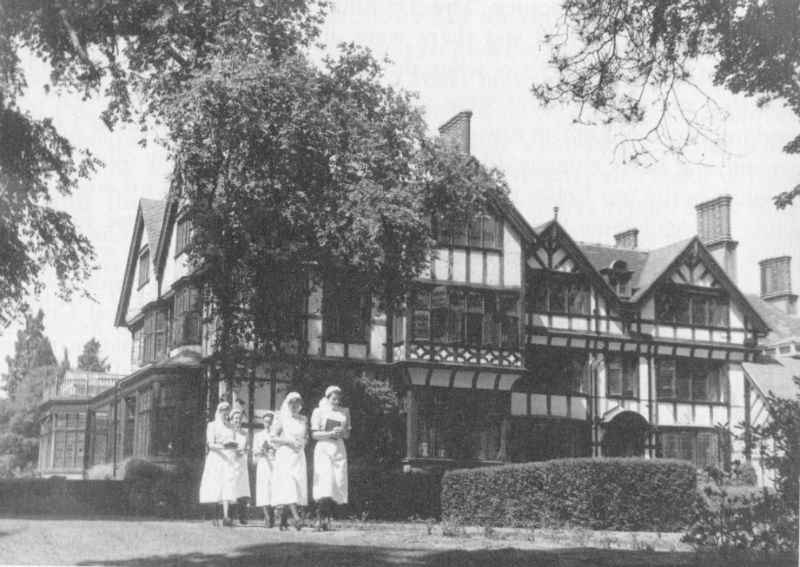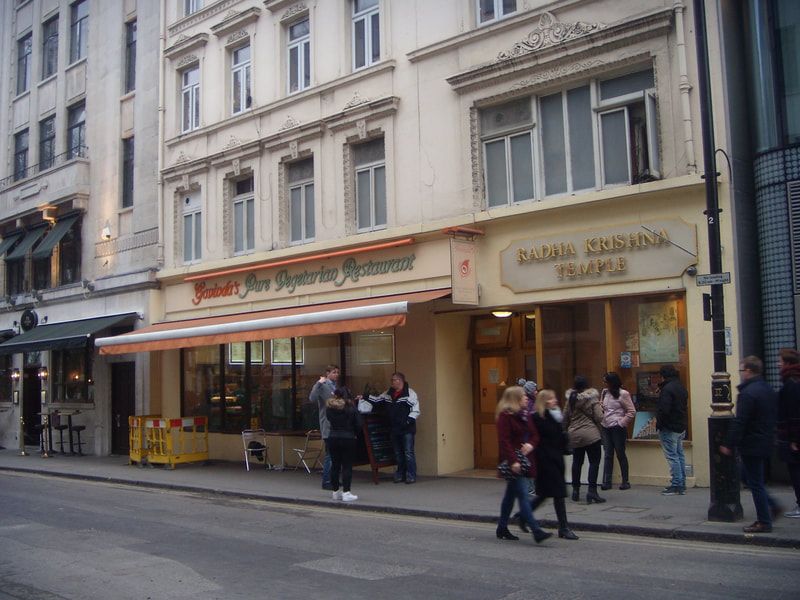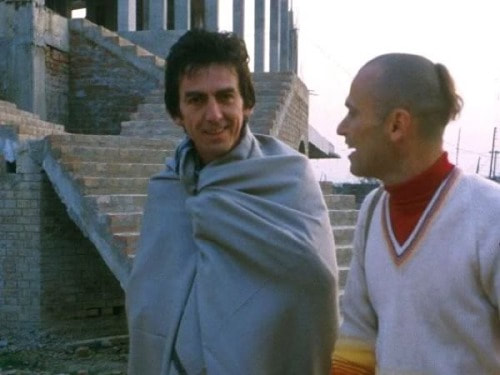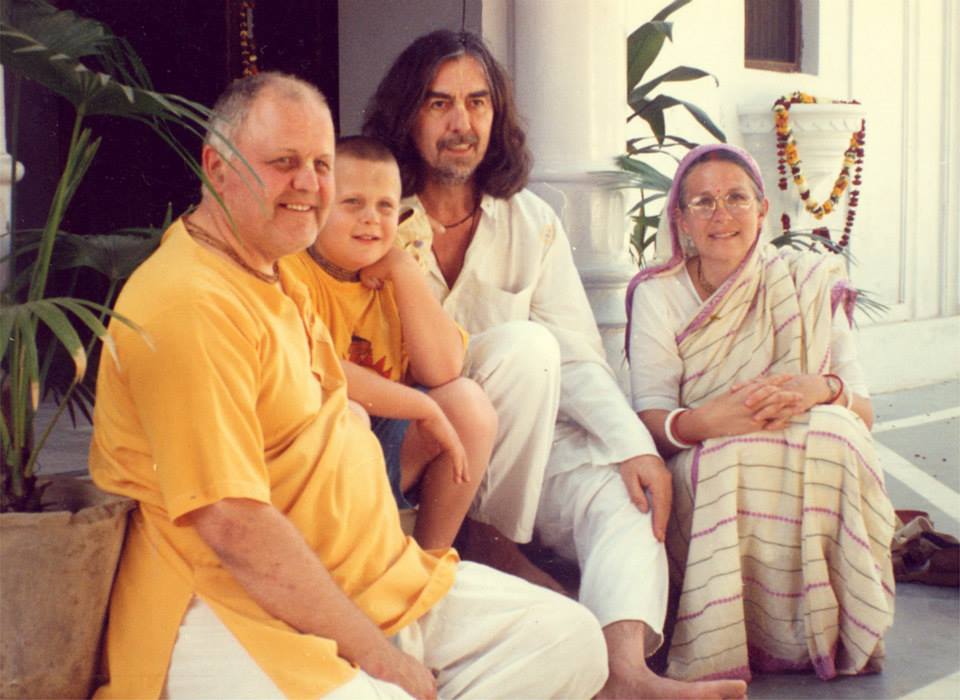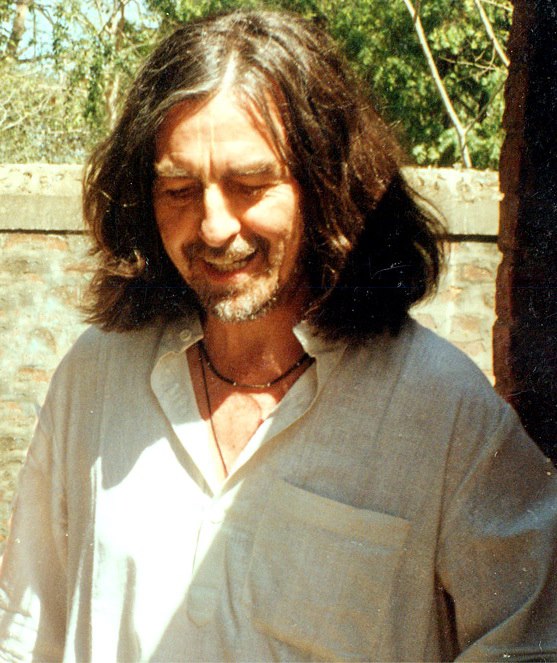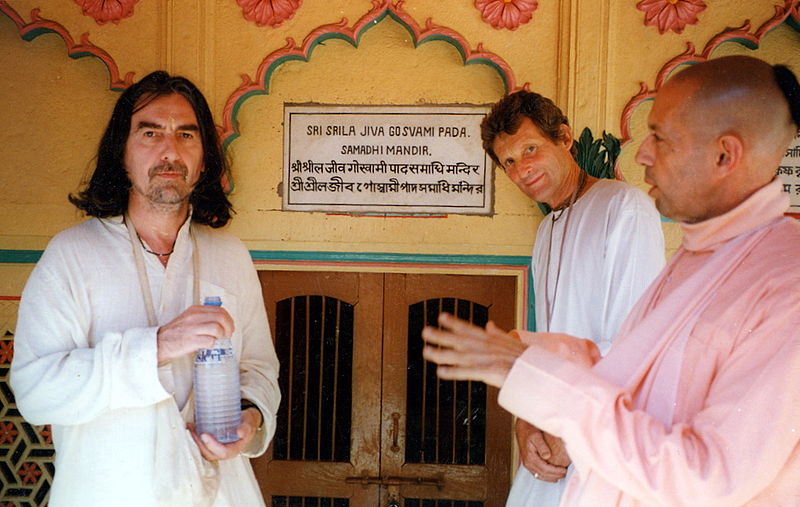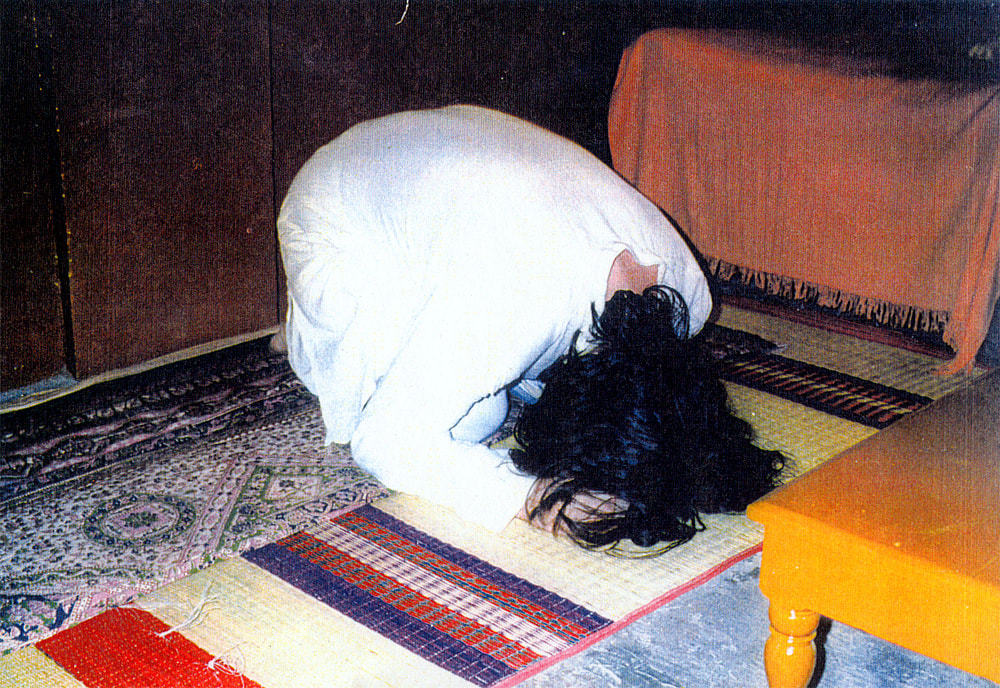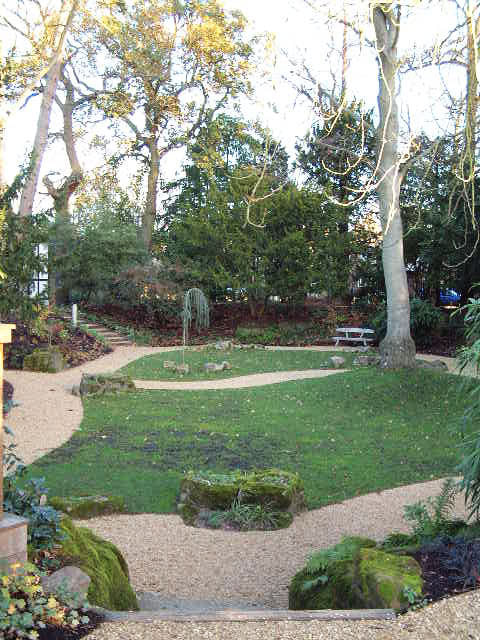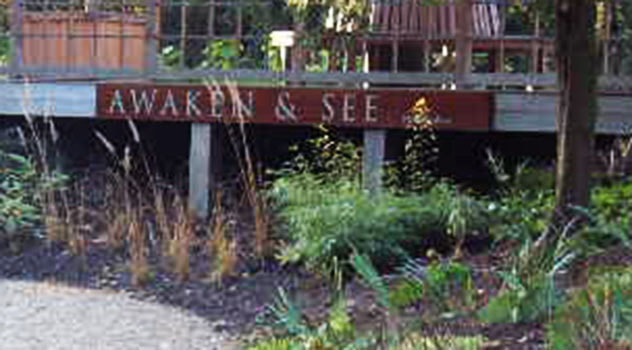Continued from His Sweet Lord... http://www.forgeorge.co.uk/his-sweet-lord.html
The story of a shy young man from Liverpool who turned into something of an evangelist :-)
After spending a happy Thanksgiving in New York with Dylan, The Band and Al Aronowitz in November 1968 George returned to a still uncomfortable atmosphere with The Beatles . And then the door that George had been knocking on opened.
"Just certain things happened in my life which left me thinking 'What's it all about, Alfie?' and I remembered Jesus said somewhere 'Knock and the door shall be opened' and I said (knock, knock) 'Hellooo!' “
One day in December 1968 when George came down the stairs from a meeting he saw a Hare Krishna devotee in the Reception at Apple. Six devotees (Three couples) had been sent to try to make contact with The Beatles. George expressed his delight saying "Where have you been?" and from the very beginning formed a firm friendship with Syamasundara.
"The first time I met Syamasundara, I liked him. He was my pal. I'd read about Prabhupada coming from India to Boston on the back of his record, and I knew that Syamasundara and all of you were in my age group, and that the only difference, really, was that you'd already joined and I hadn't. I was in a rock band, but I didn't have any fear, because I had seen dhotis, your robes, and the saffron color and shaved heads in India. Krishna consciousness was especially good for me because I didn't get the feeling that I'd have to shave my head, move into a temple, and do it full time. So it was a spiritual thing that just fit in with my life-style. I could still be a musician, but I just changed my consciousness, that's all."
George invited the devotees to Kinfauns (his home in Esher where they also met the other Beatles) and he would visit them at their lodgings at 22 Betterton Street, London which is very close to the British Museum (today it is aptly the location of The Poetry Cafe, The Poetry Society). The devotees would recall the sound of his sports car pulling up outside and his enjoyment of the vegetarian foods that were spiritualised by being offered to Krishna first, prasadam.
"Well, we should try to see God in everything, so it helps so much having the food to taste. Let's face it, if God is in everything, why shouldn't you taste Him when you eat? I think that prasadam is a very important thing. Krishna is God, so He's absolute: His name, His form, prasadam, it's all Him. They say the way to a man's heart is through his stomach, so if you can get to a man's spirit soul by eating, and it works, why not do it? There's nothing better than having been chanting and dancing, or just sitting and talking philosophy, and then suddenly the devotees bring out the prasadam. It's a blessing from Krishna, and it's spiritually important. The idea is that prasadam is the sacrament the Christians talk about, only instead of being just a wafer, it's a whole feast, really, and the taste is so nice--it's out of this world. And prasadam's a good little hook in this age of commercialism. When people want something extra, or they need to have something special, prasadam will hook them in there. It's undoubtedly done a great deal toward getting a lot more people involved in spiritual life. It breaks down preju dices, too. Because they think, "Oh, well, yes, I wouldn't mind a drink of whatever or a bite of that." Then they ask, "What's this?" and "Oh, well, it's prasadam." And they get to learn another aspect of Krishna consciousness. Then they say, "It actually tastes quite nice. Have you got another plateful?" I've seen that happen with lots of people, especially older people I've seen at your temples. Maybe they were a little prejudiced, but the next thing you know, they're in love with prasadam, and eventually they walk out of the temple thinking, "They're not so bad after all." …
I really like those deep-fried cauliflower things--pakoras?...
And one thing I always liked was rasamalai [a milk sweet]. And there's a lot of good drinks as well, fruit juices and lassi, the yogurt drinks mixed with fruit, and sometimes with rose water."
George looked very well on pakoras and rasamalai :-)
In 1971 during the rehearsals for The Concerts for Bangladesh, the Krishas would bring prasadam for the Artistes and stagehands to enjoy.
George was co-signor for the first iskcon Temple in the UK at Bury Place, Bloomsbury.
1969 continued with the complications of a drug bust by the notorious Sgt Plcher who was later imprisoned for four years In September 1973 with the judge saying to the disgraced ex-policeman, "You poisoned the wells of criminal justice, and set about it deliberately."
At the same time George's beloved Mother, Louise, developed serious health problems with George having to take physical action on the family practitioner so that she could be transferred to Hospital and receive the special care that she needed. It is good to know that he had extra support from the devotees at this time.
From his first visit to the Devotees, George would play on the harmonium, accompanied occasionally by Billy Preston on sysnthesizer. After one of these 'kirtans' George decided to produce a record for the movement. He telephoned the devotees saying “You're going to make a record” and asked them to come to Abbey Road the same evening. wiki
Shortly before the session George went through the arrangement with his other great devotee friend Mukunder (who had been a pianist with jazz saxophonist Pharoah Sanders) on piano.
George was co-signor for the first iskcon Temple in the UK at Bury Place, Bloomsbury.
1969 continued with the complications of a drug bust by the notorious Sgt Plcher who was later imprisoned for four years In September 1973 with the judge saying to the disgraced ex-policeman, "You poisoned the wells of criminal justice, and set about it deliberately."
At the same time George's beloved Mother, Louise, developed serious health problems with George having to take physical action on the family practitioner so that she could be transferred to Hospital and receive the special care that she needed. It is good to know that he had extra support from the devotees at this time.
From his first visit to the Devotees, George would play on the harmonium, accompanied occasionally by Billy Preston on sysnthesizer. After one of these 'kirtans' George decided to produce a record for the movement. He telephoned the devotees saying “You're going to make a record” and asked them to come to Abbey Road the same evening. wiki
Shortly before the session George went through the arrangement with his other great devotee friend Mukunder (who had been a pianist with jazz saxophonist Pharoah Sanders) on piano.
George's Soul Sister Yamuna was to sing lead with Shyamsundara backing. Yamuna was a lovely devotee who was wont to break with convention and throw her arms around George when greeting him, much to the disapproval of some of the Temple Elders ~ but much to the approval of George :-) At the recording also present were Mal Evans and Chris O'Dell who was invited (along with her Mother) to join the backing chorus. "Chanting the words over and over again was almost hypnotic … there was a point of freedom where there was no effort at all, no criticism or judgment, just the sound generated from deep inside, like a flame that warmed us from the inside out.” Miss O'Dell 2009. The b side consisted of 'Prayer to the Spiritual Masters'.
(just visible in the last photo also Paul and Linda McCartney in the Control Room)
On 28th August George joined the Devotees for a Press Conference in the gardens of a large house in Sydenham in South London.
“I felt it was important to try and be precise, to tell them and let them know. You know, to come out of the closet and really tell them. Because once you realize something, then you can't pretend you don't know it any more.
I figured this is the space age, with airplanes and everything. If everyone can go around the world on their holidays, there's no reason why a mantra can't go a few miles as well. So the idea was to try to spiritually infiltrate society, so to speak. After I got Apple Records committed to you and the record released, and after our big promotion, we saw it was going to become a hit. And one of the greatest things, one of the greatest thrills of my life, actually, was seeing you all on BBC's Top of the Pops. I couldn't believe it. It's pretty hard to get on that program, because they only put you on if you come into the Top 20. It was just like a breath of fresh air. My strategy was to keep it to a three-and-a-half-minute version of the mantra so they'd play it on the radio, and it worked. I did the harmonium and guitar track for that record at Abbey Road studios before one of the Beatles' sessions and then overdubbed a bass part. I remember Paul McCartney and his wife, Linda, arrived at the studio and enjoyed the mantra.”
After the launch George went directly to the Isle of Wight where Dylan was appearing at the Festival. In the period before Dylan took to the stage on 31 August, the single was aired on the PA system. (George was so canny at marketing causes he believed in.)
“They played it while they were getting the stage set up for Bob. It was great. Besides, it was a catchy tune, and the people didn't have to know what it meant in order to enjoy it. I felt very good when I first heard it was doing well. "
It was also played at half time at Manchester United Football Club. The single reached no. 12 in the UK and no. 15 in West Germany.
“I felt it was important to try and be precise, to tell them and let them know. You know, to come out of the closet and really tell them. Because once you realize something, then you can't pretend you don't know it any more.
I figured this is the space age, with airplanes and everything. If everyone can go around the world on their holidays, there's no reason why a mantra can't go a few miles as well. So the idea was to try to spiritually infiltrate society, so to speak. After I got Apple Records committed to you and the record released, and after our big promotion, we saw it was going to become a hit. And one of the greatest things, one of the greatest thrills of my life, actually, was seeing you all on BBC's Top of the Pops. I couldn't believe it. It's pretty hard to get on that program, because they only put you on if you come into the Top 20. It was just like a breath of fresh air. My strategy was to keep it to a three-and-a-half-minute version of the mantra so they'd play it on the radio, and it worked. I did the harmonium and guitar track for that record at Abbey Road studios before one of the Beatles' sessions and then overdubbed a bass part. I remember Paul McCartney and his wife, Linda, arrived at the studio and enjoyed the mantra.”
After the launch George went directly to the Isle of Wight where Dylan was appearing at the Festival. In the period before Dylan took to the stage on 31 August, the single was aired on the PA system. (George was so canny at marketing causes he believed in.)
“They played it while they were getting the stage set up for Bob. It was great. Besides, it was a catchy tune, and the people didn't have to know what it meant in order to enjoy it. I felt very good when I first heard it was doing well. "
It was also played at half time at Manchester United Football Club. The single reached no. 12 in the UK and no. 15 in West Germany.
The record sold 70,000 copies on its first day.
George waits for Dylan's set at The Isle of Wight Concert 31 August 1969 ~ The HARE KRISHNA is played before his set.
George got such a kick out of watching the devotees whirling on the set of Top of the Pops :-)
In September 1969 George met the Founder of ISKCON, Srila Prabhupada, who had been invited to stay with John Lennon at Tittenhurst Park.
"Yes, but when I met him at first, I underestimated him. I didn't realize it then, but I see now that because of him, the mantra has spread so far in the last sixteen years, more than it had in the last five centuries. Now that's pretty amazing, because he was getting older and older, yet he was writing his books all the time. I realized later on that he was much more incredible than what you could see on the surface.
The thing that always stays is his saying, "I am the servant of the servant of the servant." I like that. A lot of people say, "I'm it. I'm the divine incarnation. I'm here and let me hip you." You know what I mean? But Prabhupada was never like that. I liked Prabhupada's humbleness. I always liked his humility and his simplicity The servant of the servant of the servant is really what it is, you know. None of us are God--just His servants. He just made me feel so comfortable. I always felt very relaxed with him, and I felt more like a friend. I felt that he was a good friend. Even though he was at the time seventy-nine years old, working practically all through the night, day after day, with very little sleep, he still didn't come through to me as though he was a very highly educated intellectual being, because he had a sort of childlike simplicity. Which is great, fantastic. Even though he was the greatest Sanskrit scholar and a saint, I appreciated the fact that he never made me feel uncomfortable. In fact, he always went out of his way to make me feel comfortable. I always thought of him as sort of a lovely friend, really, and now he's still a lovely friend. "
George wrote 'The Lord Loves the One (that loves the Lord)' for Prabhupad. It was released in 1973 on 'Living in The Material World' in May 1973.
"Yes, but when I met him at first, I underestimated him. I didn't realize it then, but I see now that because of him, the mantra has spread so far in the last sixteen years, more than it had in the last five centuries. Now that's pretty amazing, because he was getting older and older, yet he was writing his books all the time. I realized later on that he was much more incredible than what you could see on the surface.
The thing that always stays is his saying, "I am the servant of the servant of the servant." I like that. A lot of people say, "I'm it. I'm the divine incarnation. I'm here and let me hip you." You know what I mean? But Prabhupada was never like that. I liked Prabhupada's humbleness. I always liked his humility and his simplicity The servant of the servant of the servant is really what it is, you know. None of us are God--just His servants. He just made me feel so comfortable. I always felt very relaxed with him, and I felt more like a friend. I felt that he was a good friend. Even though he was at the time seventy-nine years old, working practically all through the night, day after day, with very little sleep, he still didn't come through to me as though he was a very highly educated intellectual being, because he had a sort of childlike simplicity. Which is great, fantastic. Even though he was the greatest Sanskrit scholar and a saint, I appreciated the fact that he never made me feel uncomfortable. In fact, he always went out of his way to make me feel comfortable. I always thought of him as sort of a lovely friend, really, and now he's still a lovely friend. "
George wrote 'The Lord Loves the One (that loves the Lord)' for Prabhupad. It was released in 1973 on 'Living in The Material World' in May 1973.
3 George with Prabhupad and Pattie 1973 and George with Prabhupad 1973
In January 1970 George purchased Friar Park, a Grade II Listed neo-Gothic mansion with 120 rooms set in 62 acres from a group of Salesian Nuns who could no longer afford the property. The magnificent house had been built in 1889 by Sir Frank Crisp an eccentric Lawyer and came complete with underground caves linked by passages, a Blue Grotto and a mini scale Matterhorn topping an Alpine Garden as well as ornamental lakes. The lakes were now full of discarded refuse and the house was due to be demolished. When negotiations were complete George horrified the Nuns by placing a picture of Vishnu in the fireplace... he consoled them by saying that God had many forms. In fact the Nuns left a statue of The Blessed Virgin Mary behind and this became one of George's most treasured objects.
“When I first came to this house, it was occupied by nuns. I brought in this poster of Visnu [a four-armed form of Krishna]. You just see His head and shoulders and His four arms holding a conchshell and various other symbols, and it has a big om. This transcendental syllable, which represents Krishna, has been chanted by many persons throughout history for spiritual perfection.* written above it. He has a nice aura around Him. I left it by the fireplace and went out into the garden. When we came back in thc house, they all pounced on me, saying, "Who is that? What is it?" as if it were some pagan god. So I said, "Well, if God is unlimited, then He can appear in any form, whichever way He likes to appear. That's one way. He's called Visnu." It sort of freaked them out a bit, but the point is, why should God be limited? Even if you get Him as Krishna, He is not limited to that picture of Krishna. He can be the baby form, He can be Govinda and manifest in so many other well-known forms. You can see Krishna as a little boy, which is how I like to see Krishna. It's a joyful relationship. But there's this morbid side to the way many represent Christianity today, where you don't smile, because it's too serious, and you can't expect to see God--that kind of stuff. If there is God, we must see Him, and I don't believe in the idea you find in most churches, where they say, "No, you're not going to see Him. He's way up above you. Just believe what we tell you and shut up."
George used to say that things stepped up when he moved to Friar Park and that he felt the subtle presence of Sir Frank. He wrote this beautiful tune ~ later released on 'All Things Must Pass'.
In January 1970 George purchased Friar Park, a Grade II Listed neo-Gothic mansion with 120 rooms set in 62 acres from a group of Salesian Nuns who could no longer afford the property. The magnificent house had been built in 1889 by Sir Frank Crisp an eccentric Lawyer and came complete with underground caves linked by passages, a Blue Grotto and a mini scale Matterhorn topping an Alpine Garden as well as ornamental lakes. The lakes were now full of discarded refuse and the house was due to be demolished. When negotiations were complete George horrified the Nuns by placing a picture of Vishnu in the fireplace... he consoled them by saying that God had many forms. In fact the Nuns left a statue of The Blessed Virgin Mary behind and this became one of George's most treasured objects.
“When I first came to this house, it was occupied by nuns. I brought in this poster of Visnu [a four-armed form of Krishna]. You just see His head and shoulders and His four arms holding a conchshell and various other symbols, and it has a big om. This transcendental syllable, which represents Krishna, has been chanted by many persons throughout history for spiritual perfection.* written above it. He has a nice aura around Him. I left it by the fireplace and went out into the garden. When we came back in thc house, they all pounced on me, saying, "Who is that? What is it?" as if it were some pagan god. So I said, "Well, if God is unlimited, then He can appear in any form, whichever way He likes to appear. That's one way. He's called Visnu." It sort of freaked them out a bit, but the point is, why should God be limited? Even if you get Him as Krishna, He is not limited to that picture of Krishna. He can be the baby form, He can be Govinda and manifest in so many other well-known forms. You can see Krishna as a little boy, which is how I like to see Krishna. It's a joyful relationship. But there's this morbid side to the way many represent Christianity today, where you don't smile, because it's too serious, and you can't expect to see God--that kind of stuff. If there is God, we must see Him, and I don't believe in the idea you find in most churches, where they say, "No, you're not going to see Him. He's way up above you. Just believe what we tell you and shut up."
George used to say that things stepped up when he moved to Friar Park and that he felt the subtle presence of Sir Frank. He wrote this beautiful tune ~ later released on 'All Things Must Pass'.
George invited the devotees to stay with him at Friar Park and help out with the restorations .
He had his own altar and in fact he had a travelling altar as well (to be discussed further in 'His Sweet Lord'
On 7 February 1970 George produced another single, this time at Trident Studios. The arrangement was by Mukhunda with orchestral instrumentation by John Barham. It consisted of another traditional chant 'Govinda' ~ Klaus Voormann played bass and Alan White was on drums with Ken Scott as Engineer. There were also members of the Temple and musicians from The London Philharmonic Orchestra. Again this had the soaring voice of Yamuna. George had offered to make her a rock star but she had very sensibly declined :-) Govinda Jai Jai was on the b side.

To this day, in accordance with Prabhupad's wishes Govinda is played every morning at the Sundar Arti in every ISKCON Temple around the world.
Mukunda: In one of his books, Prabhupada said that your sincere service was better than some people who had delved more deeply into Krishna consciousness but could not maintain that level of commitment. How did you feel about this?
George: Very wonderful, really. I mean it really gave me hope, because as they say, even one moment in the company of a divine person, Krishna's pure devotee, can help a tremendous amount.
And I think Prabhupada was really pleased at the idea that somebody from outside of the temple was helping to get the album made. Just the fact that he was pleased was encouraging to me. I knew he liked "The Hare Krishna Mantra" record, and he asked the devotees to play that song "Govinda." They still play it, don't they?
Mukunda: Every temple has a recording of it, and we play it each morning when the devotees assemble before the altar, before kirtana. It's an ISKCON institution, you might say.
In a letter dated 8 February 1970 Prabhupad also acknowledged the donation made by George which made possible the printing of his KRSNA book as well as the marble slab for the Bury Place Temple...
“Sriman George Harrison has certainly done an unique service by contributing $19,000 for publishing my Krsna book. When I was in London, he saw me four times and he was very submissive and devout and he was not at all proud of his very well-to-do material position. He has a reputation as a first class musician and he is considered to be rich or as they say one of the richest men in the world. Still he was not at all puffed up, but was humble, meek, polite, and devout. So all these qualities and his service to Krishna will certainly help him in his advancement of Krishna Consciousness. Thus I see that although he is not an initiated disciple, still he has been trying to help us in so many ways.
This change of his heart has been possible by the endeavor of Syamasundara.. Syamasundara. tried to win his friendship by all means and the result obtained thereof was offered to Krishna. In the London Temple the first class Italian marble throne worth about $3,000 was also contributed by George through the service of Syamasundara.. So actually George’s leaning towards Krishna Consciousness has been greatly influenced by Syamasundara.’s endeavor.”
Krishna Krishna, Hare Hare
Hare Rama, Hare Rama
I request that you take advantage of this book KRSNA, and enter into its understanding. I also request that you make an appointment to meet your God now, through the self liberating process of YOGA (UNION) and
GIVE PEACE A CHANCE.
All you need in Love
(Krishna)Hari Bol
George Harrison 31/3/1970
Mukunda: In one of his books, Prabhupada said that your sincere service was better than some people who had delved more deeply into Krishna consciousness but could not maintain that level of commitment. How did you feel about this?
George: Very wonderful, really. I mean it really gave me hope, because as they say, even one moment in the company of a divine person, Krishna's pure devotee, can help a tremendous amount.
And I think Prabhupada was really pleased at the idea that somebody from outside of the temple was helping to get the album made. Just the fact that he was pleased was encouraging to me. I knew he liked "The Hare Krishna Mantra" record, and he asked the devotees to play that song "Govinda." They still play it, don't they?
Mukunda: Every temple has a recording of it, and we play it each morning when the devotees assemble before the altar, before kirtana. It's an ISKCON institution, you might say.
In a letter dated 8 February 1970 Prabhupad also acknowledged the donation made by George which made possible the printing of his KRSNA book as well as the marble slab for the Bury Place Temple...
“Sriman George Harrison has certainly done an unique service by contributing $19,000 for publishing my Krsna book. When I was in London, he saw me four times and he was very submissive and devout and he was not at all proud of his very well-to-do material position. He has a reputation as a first class musician and he is considered to be rich or as they say one of the richest men in the world. Still he was not at all puffed up, but was humble, meek, polite, and devout. So all these qualities and his service to Krishna will certainly help him in his advancement of Krishna Consciousness. Thus I see that although he is not an initiated disciple, still he has been trying to help us in so many ways.
This change of his heart has been possible by the endeavor of Syamasundara.. Syamasundara. tried to win his friendship by all means and the result obtained thereof was offered to Krishna. In the London Temple the first class Italian marble throne worth about $3,000 was also contributed by George through the service of Syamasundara.. So actually George’s leaning towards Krishna Consciousness has been greatly influenced by Syamasundara.’s endeavor.”
- George's forward for the book read :
- Everybody is looking for KRISHNA.
- Some don't realize that they are, but they are.
- KRISHNA is GOD, the Source of all that exists, the Cause of all that is, was, or ever will be.
- As GOD is unlimited HE has many Names.
- Allah-Buddha-Jehova-Rama: All are KRISHNA, all are ONE.
- God is not abstract; He has both the impersonal and the personal aspects to His personality which is SUPREME, ETERNAL, BLISSFUL, and full of KNOWLEDGE. As a single drop of water has the same qualities as an ocean of water, so has our consciousness the qualities of GOD'S consciousness... but through our identification and attachment with material energy (physical body, sense pleasures, material possessions, ego, etc.) our true TRANSCENDENTAL CONSCIOUSNESS has been polluted, and like a dirty mirror it is unable to reflet a pure image.
- With many lives our association with the TEMPORARY has grown. This impermanent body, a bag of bones and flesh, is mistaken for our true self, and we have accepted this temporary condition to be final.
- Through all ages, great SAINTS have remained as living proof that this non-temporary, permanent state of GOD CONSCIOUSNESS can be revived in all living Souls. Each soul is potentially divine. Krsna says in Bhagavad Gita: "Steady in the Self, being freed from all material contamination, the yogi achieves the highest perfetional stage of happiness in touch with the Supreme Consciousness." (VI,28)
- YOGA (a scientific method for GOD (SELF) realization) is the process by which we puirify our consciousness, stop further pollution, and arrive at the state of Perfection, full KNOWLEDGE, full BLISS.
- If there's a God, I want to see Him. It's pointless to believe in something without proof, and Krishna Consciousness and meditation are methods where you can actually obtain GOD preception. You can actually see God, and Hear Him, play with Him. It might sound crazy, but He is actually there, actually with you.
- There are many yogic Paths--Raja, Jnana, Hatha, Kriya, Karma, Bhakti--which are all acclaimed by the MASTERS of each method.
- SWAMI BHAKTIVEDANTA is as his title says, a BHAKTI Yogi following the path of DEVOTION. By serving GOD through each thought, word, and DEED, and by chanting HIS Holy Names, the devotee quickly develops God-consciousness. By chanting
Krishna Krishna, Hare Hare
Hare Rama, Hare Rama
I request that you take advantage of this book KRSNA, and enter into its understanding. I also request that you make an appointment to meet your God now, through the self liberating process of YOGA (UNION) and
GIVE PEACE A CHANCE.
All you need in Love
(Krishna)Hari Bol
George Harrison 31/3/1970
On 21 May 1970 George produced an Album 'The Radha Krishna Temple' through Apple. It contained the two previous singles as well as other Sanskrit devotional songs that George had recorded with the Devotees in between with arrangements by Mukunda as before.
George asked more than once to enter the Temple but was dissuaded by Prabhupad
I think George does not require to become my formal disciple because he is already more than my disciple. He has sympathy for my movement and I have all blessings for him." march 15, 1970
1970, although a period of great liberation in which he could finally pour out his music which had been waiting for so many years, was also a period of great trauma for George. The three largest stones in the foundations of his life were under threat ~ The Beatles dissolved their partnership and the Band, George's marriage to Patti was in tatters and his Mother Louise had lain ill fo 9 months in a coma. He would break away from recording what would be his masterpiece 'All Things Must Pass' to visit her in Warrington General Hospital to where she had been transferred from Clatterbridge Hospital. Finally, she passed away at the age of 59 ~ George chanted Hare Krishna softly into her ear so that she would in the Hindu belief achieve liberation from the wheel of Reincarnation.
He wrote this sad tune for her
On the 23rd November 1970 , in the US, George released what was to be the biggest hit of his career (twice). In the UK it had to wait until 15th January 1971 to be released as a single but it was released on his epic album "All Things Must Pass" on 27th November (to be discussed further in 'His Sweet Lord' at a later date). My Sweet Lord was George's way of getting people to chant Hare Krishna without them realising it. It was his love song to Krishna at that time expressing his desire for a direct relationship ~ it was a sentiment that could be understood by anyone regardless of their religious leanings.
My idea in "My Sweet Lord," because it sounded like a "pop song," was to sneak up on them a bit. The point was to have the people not offended by "Hallelujah," and by the time it gets to "Hare Krishna" they're already hooked, and their foot's tapping, and they're already singing along "Hallelujah," to kind of lull them into a sense of false security. And then suddenly it turns into "Hare Krishna," and they will all be singing that before they know what's happened, and they will think, "Hey, I thought I wasn't supposed to like Hare Krishna!"
My Sweet Lord had sold over 1 million copies by December 26 andachieved No 1 status in the US. It achieved international No 1 status by the end of 1970 and through the early part of 1971. It was the first Solo Beatle recored to achieve that status and to this day remains the biggest selling solo record by any of The Beatles ~ all without any promotional interviews or concert appearances. You can read much more about its success on wikipedia and the comments of the people who heard it on the radio. The fact was that George had gotten his beliefs out there in a way that people loved and did not wish to avoid. The song (reworked) was re released after his passing and it achieved No. 1 status again.
Here is George performing My Sweet Lord at the Concerts for Bangladesh on August 1st 1971 ~ in 3 D !!! You need to get your glasses that you wore for the last Marvel film!
Somehow George also found time to go to Paris to help the Krishnas with the purchase of some property so that they could establish themselves in France as they had done in the United Kingdom. Whilst he was there he gave a Press Conference. George told a funny story about how the Press broke down the door in their frenzy and he escaped with Shyansundara down a laundry chute and hailed a passing taxi and told the driver " Allez, allez" See last photo found on meetthebeatlesforreal ... Also present is Yamuna
In 1973 George purchased Piggot's Manor in Hertfordshire. The property had a Tudor House on it as early as the 16th Century which had subsequently been demolished in 1884 and replaced with the mock Tudor house that still stands there today as a Grade II listed building with 17 acres of land. When George purchased the property it was St Bartholomew's Nursing College. George had researched the location very carefully and found that it was situated on important ley lines. George leased the property to the Krishnas for the peppercorn rent of a penny a year (an ancient English legal term for a nominal rent fixed in order to form the basis of a Contract). After John Lennon's assassination in 1980 ISKCON asked George for permission to purchase the property and George instructed his Lawyers to sell the property at the very cheapest possible price.
In a conversation on July 9 1973 Prabhupad said "Hare Kṛṣṇa. Jaya. First when I entered this room, I said, 'All glories to George Harrison.' (laughs) Yes. You have given us this shelter, and Kṛṣṇa will give you shelter at His lotus feet. We shall pray always like that. Yes." (It is the custom at the end of an Arti for the devoties to bow and pay obeisances to their Spiritual Masters saying 'All Glories to..' )
George'In this wonderf'ul interview George discusses how the preaching of Hare Krishna sometimes seems to cause animosity. It is probably the biggest divisive factor amongst George 'fans' with the attitude being that George is allowed this wierd quirk only because he is loved.
They also converse about George's latest album 'Living in the Material World' released in May 1973. George dedicated the Album to Lord Krishna stating "All Glories to Sri Krsna" together with the Om symbol on the back cover of the album. The Front cover featured a Kirlian photo of George's hand holding a Hindu medallion whereas on the back cover George holds US coins (showing the contrast between the Material and the Spiritual). The Lyric sheet insert featured artwork from the Bhagavad Gita As It Is (The translation by Prabhupad) showing Krishna with Arjuna being pulled by Uchaihshravas the seven headed horse (later used for the symbol of George's Dark Horse Records). Here is the title track
They also converse about George's latest album 'Living in the Material World' released in May 1973. George dedicated the Album to Lord Krishna stating "All Glories to Sri Krsna" together with the Om symbol on the back cover of the album. The Front cover featured a Kirlian photo of George's hand holding a Hindu medallion whereas on the back cover George holds US coins (showing the contrast between the Material and the Spiritual). The Lyric sheet insert featured artwork from the Bhagavad Gita As It Is (The translation by Prabhupad) showing Krishna with Arjuna being pulled by Uchaihshravas the seven headed horse (later used for the symbol of George's Dark Horse Records). Here is the title track
By 1977 Bury Place had become too small and the ISKCON London Temple moved to its new location at 10 Soho Street ~ a spiritual oasis in the very heart of London. At the very top is a lovely little greenouse housing the precious tulsi (basil) plants loved by Lord Krishna. Patti used to grow them for George at Friar Park. George visited both the Manor and the Temple in Soho many times during his life. They have a wonderful Vegetarian restaurant called Govinda which George would definitely have enjoyed :-)
The following images were taken on 25 February 2017 when we had a Harinam around Soho in George's honour.
When Prabhupad left his body on November 14, 1977, in Vrindavan, India, in his rooms at the Krishna-Balarama temple he was surrounded by hundreds of his disciples chanting Hare Krishna. He removed the ring from his right hand and said 'This is for George, give it to him.' "
|
Many of the quotes in this Tribute have been borrowed from an Interview with George: George and Mukunda in 1982 ~ you can read it all on the link below
George: Oh, yeah. I have my beads. I remember when I first got them, they were just big knobby globs of wood, but now I’m very glad to say that they’re smooth from chanting a lot. |
https://theharekrishnamovement.org/2016/07/14/george-harrison-interview-hare-krishna-mantra-theres-nothing-higher-1982/
George visited Mayapur which is the Headquarters of ISKCON in 1983 ~ He spent a long time chatting with the Head Gardner getting advice with regards to tropical plants as he was looking for a property in Australia.
George visited Mayapur which is the Headquarters of ISKCON in 1983 ~ He spent a long time chatting with the Head Gardner getting advice with regards to tropical plants as he was looking for a property in Australia.
George visited Vrindavan, The Birthplace of Lord Krishna, many times in 1974 (with Ravi Shankar) and in 1976 (with Olivia Trinidad Arias) which will be discussed further in 'His Sweet Lord') and the final time was in 1996 when he was re-united with his old Devotee mates. After his inspirational visit to Vrindavan in 1974 with Ravi Shankar George was moved to write the following tune released on his Dark Horse album in December 1974
In 1997 The Bhaktivedanta Book Trust published a delightful little book called 'Chant and Be Happy' ~ Chapter Two consists of a conversation with George, John and Yoko at Tittenhurst in 1969. For the preface George wrote:
Everybody is looking for Krishna.
Some don’t realize that they are, but they are.
Krishna is God, the Source of all that exists,
the Cause of all that is, was, or ever will be.
As God is unlimited, He has many Names.
Allah-Buddha-Jehovah-Rama:
All are Krishna, all are one.
By serving God through each thought, word, and
deed, and by chanting of His Holy Names,
the devotee quickly develops God-consciousness.
By chanting
Hare Krishna, Hare Krishna
Krishna Krishna, Hare Hare
Hare Rama, Hare Rama
Rama Rama, Hare Hare
one inevitably arrives at Krishna consciousness.
(The proof of the pudding is in the eating!)
You can read the entire conversation here
Everybody is looking for Krishna.
Some don’t realize that they are, but they are.
Krishna is God, the Source of all that exists,
the Cause of all that is, was, or ever will be.
As God is unlimited, He has many Names.
Allah-Buddha-Jehovah-Rama:
All are Krishna, all are one.
By serving God through each thought, word, and
deed, and by chanting of His Holy Names,
the devotee quickly develops God-consciousness.
By chanting
Hare Krishna, Hare Krishna
Krishna Krishna, Hare Hare
Hare Rama, Hare Rama
Rama Rama, Hare Hare
one inevitably arrives at Krishna consciousness.
(The proof of the pudding is in the eating!)
You can read the entire conversation here
Photos from the meeting at Tittenhurst
Present at George's passing in Los Angeles on 29th November 2001 were his two dear Devotee friends Shyamsundara and Mukunda ~ they chanted the Hare Krishna Mantra to ensure his safe passage.
Since George's passing in 2001 the devotees have held an evening of remembrance for George every year on the 29th November organised by Sakshi Gopal who remembered his excitement when he first saw George visit the Temple. the devotees sometime share their experiences of when they saw George and one devotee remembered George's Porsche which on closer inspection you could see had the Hare Krishna Mantra inscribed in tiny lettering all over the car.
In 2013 a garden created in his honour was opened to the public and in 2017 George was also remembered in the inspiring film about Prabhupad 'Hare Krishna! The Mantra, the Movement, and the Swami Who Started It All'.
Since George's passing in 2001 the devotees have held an evening of remembrance for George every year on the 29th November organised by Sakshi Gopal who remembered his excitement when he first saw George visit the Temple. the devotees sometime share their experiences of when they saw George and one devotee remembered George's Porsche which on closer inspection you could see had the Hare Krishna Mantra inscribed in tiny lettering all over the car.
In 2013 a garden created in his honour was opened to the public and in 2017 George was also remembered in the inspiring film about Prabhupad 'Hare Krishna! The Mantra, the Movement, and the Swami Who Started It All'.
The images of George's Garden at Bhaktivedanta Manor were taken on 11 December 2011 on the occasion of the 10th Remembrance Evening for George. It was not yet open to the public but the tributes to his music and special plants and earth from Friar Park were already there. The Krishnas had been in Liverpool on 29th November 2011 at the Ten Years On Concerts in Liverpool at St. George's Hall and at the Cavern performing as well as feeding 500 people (maybe more) with delicious prasad. Therefore, they could not host their own Evening on that night. They were much loved by all the George fans. You can read about them here...
http://www.forgeorge.co.uk/ten-years-on---liverpool-remembers-george---november-29th-2011.html
http://www.forgeorge.co.uk/ten-years-on---liverpool-remembers-george---29-november-2011-the-cavern.html
George plays Prabhupad's harmonium at teh apartmentss maintained for Prabupad at Bhaktivedanta Manor. it was the occasion of the 25th Anniversary of the opening of the Manor. (please correct me if i am wrong).To George's right is Mukunda (now bald) and to his left is Shyamsundara (now with hair) :-) Also present were Gurudas another old friend (with hair and a beard) as well as Sakshi Gopal who has organised the Remembrance Evenings. (with glasses)
For information about Services or to take a look around please check out...
http://www.bhaktivedantamanor.co.uk/home/
All Glories to Sriman George Harrison ~ HARE KRISHNA
(thank you for the photo Radha Mohan Das)
(thank you for the photo Radha Mohan Das)





